As pet owners, we always strive to keep our furry friends safe and healthy.
But what happens when our curious cats get into things they shouldn’t, like shampoo? It’s not uncommon for felines to ingest substances that aren’t meant for consumption.
While shampoo may seem harmless, it can actually be quite dangerous for cats, causing symptoms ranging from vomiting to seizures. However, the real question is: how can we prevent this from happening in the first place?
By understanding why cats are attracted to shampoo and taking steps to properly store these items, we can minimize the risk of accidental ingestion. In this blog post, we’ll delve into the topic of cats and shampoo.
So, if you’re wondering what to do if your cat eats shampoo, sit back and relax – we’ve got you covered with all the information and tools you need.
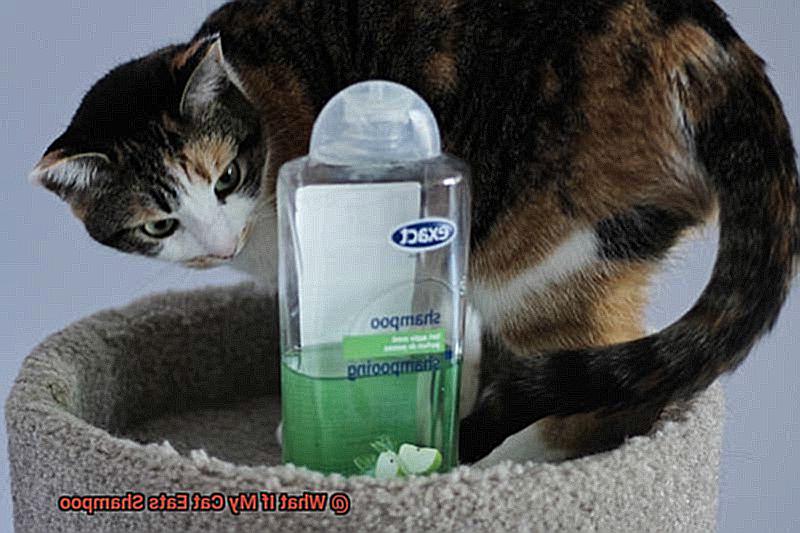
Types of Shampoos that are Dangerous for Cats
While there are plenty of safe and effective cat shampoos available, some human shampoos can be toxic to cats.
These products often contain ingredients that can cause severe skin irritation, vomiting, diarrhea, and even organ failure in cats. One of the most common culprits found in human shampoos that can be dangerous for cats is sodium lauryl sulfate (SLS).
This ingredient is a foaming agent that can cause skin irritation and allergic reactions in cats. Other harmful ingredients to watch out for include artificial fragrances, colorants, and preservatives like parabens.
However, it’s not just human shampoos that can pose a risk to cats. Some cat shampoos may also contain harmful ingredients such as pyrethrins or permethrins, commonly used in flea and tick shampoos for dogs but lethal to cats.
That’s why it’s crucial to choose a shampoo that is pH balanced for your cat’s delicate skin. Cats have more sensitive skin than humans, so selecting a shampoo that won’t dry out their skin or strip their natural oils is critical.
When in doubt, consult with your veterinarian before using any shampoo on your cat. They can recommend safe products and provide guidance on how to properly wash your cat without causing harm.
It’s also essential to keep all household cleaning products out of reach of your furry friends. Even if you’re using a safe cat shampoo, ingesting any shampoo can still pose a risk to your cat’s health.
Be vigilant and watch out for signs of shampoo ingestion in cats such as vomiting, diarrhea, or excessive drooling. If you suspect your cat has mistakenly consumed shampoo, seek medical attention from your veterinarian or a poison control center immediately.
So, choosing the right shampoo for your cat is crucial for their health and wellbeing. Avoid human shampoos and select cat shampoos that are free of harmful chemicals such as SLS, artificial fragrances, colorants, and preservatives like parabens.
Keep all household cleaning products out of reach of your furry friends to prevent any accidents from happening.
Symptoms of Shampoo Ingestion in Cats
It’s important to recognize the signs and symptoms of shampoo ingestion in cats to seek immediate veterinary care.
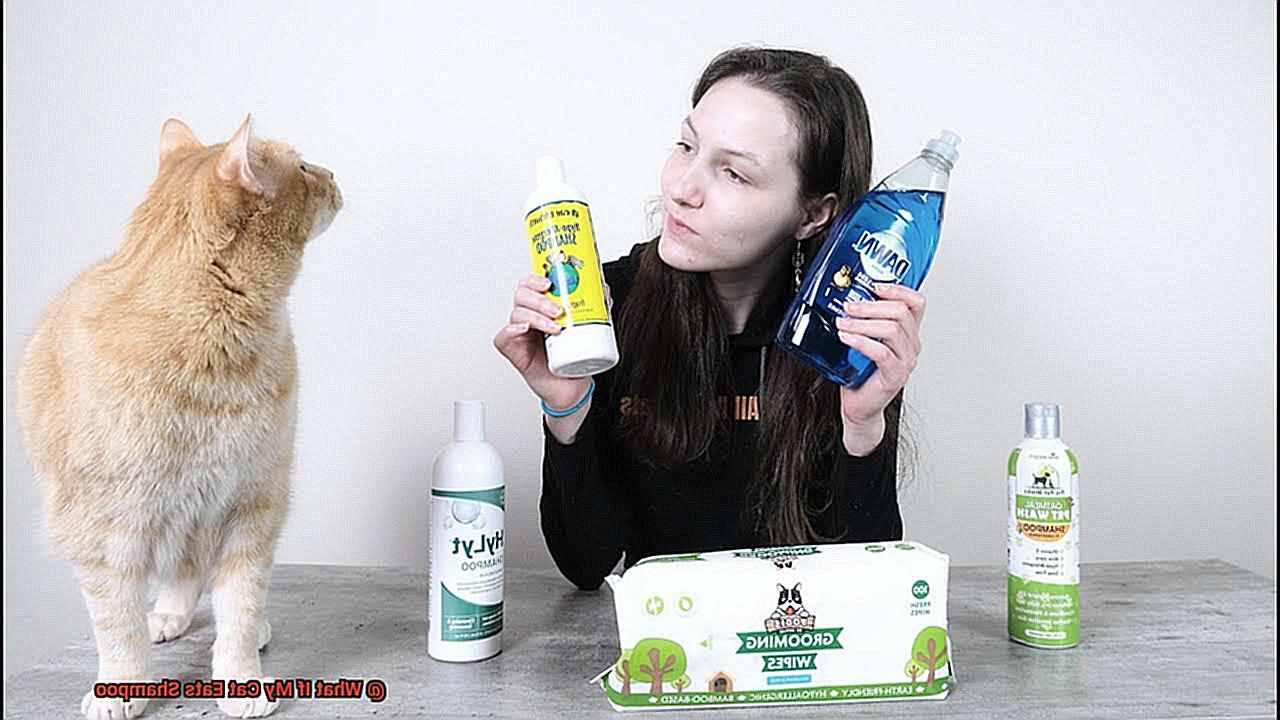
Here are the most common symptoms you should be aware of:
Vomiting
If your cat has ingested shampoo, they may vomit frequently. Just imagine how unpleasant it would feel to have a stomach full of soap suds.
The shampoo can irritate their stomach lining, leading to vomiting.
Diarrhea
Like vomiting, diarrhea is another common symptom of shampoo ingestion in cats. The irritating and inflammatory effects of shampoo on the gastrointestinal tract can cause diarrhea.
Lethargy
If your cat seems overly tired and lacks energy, it may be a sign that they have ingested shampoo.
Shampoo can cause dehydration and electrolyte imbalances, which may lead to lethargy. It’s like feeling drained after spending a day outside without enough water.
Loss of appetite
Cats that have ingested shampoo may refuse to eat or drink anything because the shampoo’s flavor and scent can be unappealing to them.
Imagine eating something that tastes like soap – not very appetizing.
Excessive drooling
Shampoo ingestion can irritate the mouth and throat, leading to excessive drooling in cats. This could be distressing for your cat and cause them to drool excessively.
Seizures
In rare cases, shampoo ingestion can cause seizures in cats due to toxicity from certain chemicals present in the shampoo.
Seizures are a medical emergency, so if you notice any signs of seizure activity in your cat, seek emergency veterinary care immediately. If you observe any of these symptoms after your cat has ingested shampoo, don’t hesitate to seek immediate veterinary attention.

Your vet will perform a thorough physical examination and may recommend blood tests to check for any abnormalities. They may also suggest administering intravenous fluids to prevent dehydration and electrolyte imbalances.
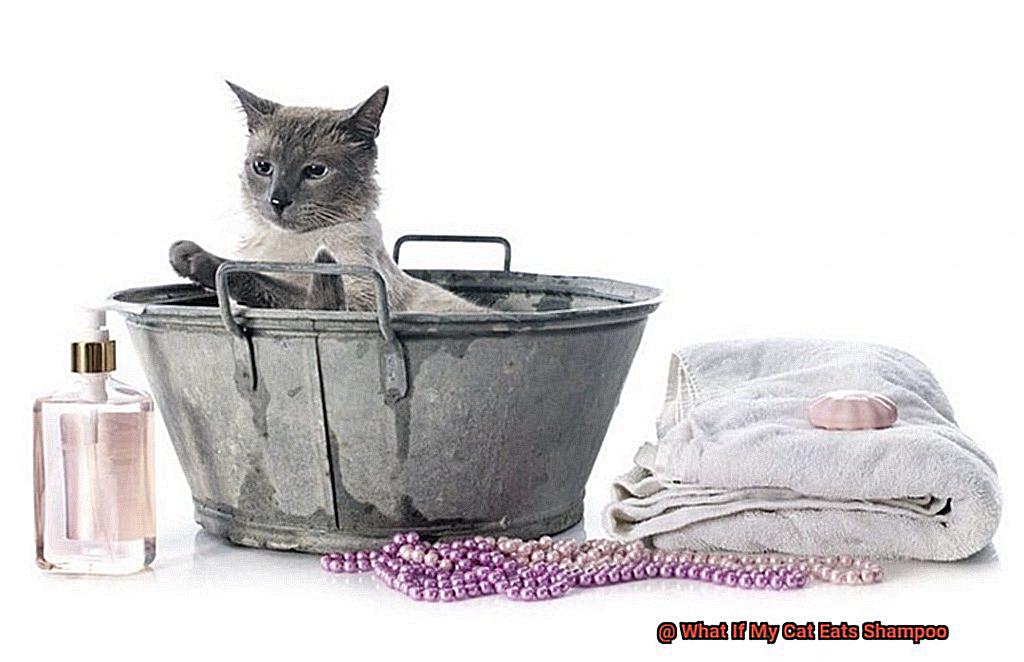
What to Do if Your Cat Eats/Licks Shampoo
It is crucial to remain calm and take swift action. Here are five essential steps to take if your cat eats or licks shampoo.
Assess the Severity of the Condition
The amount of shampoo your cat has ingested will determine the severity of the situation. If they have only taken a small amount, they may not experience any significant effects. However, if they have consumed a large quantity, it may lead to serious health issues such as vomiting or diarrhea.
Check the Ingredients List

It is essential to check the label of the shampoo bottle for any toxic ingredients such as sulfates or parabens. If you suspect that your cat has ingested a poisonous substance, contact your veterinarian immediately. They will provide you with specific instructions on what to do next, including inducing vomiting or administering activated charcoal to absorb any toxins in their system.
Rinse Your Cat’s Mouth
If your cat has only licked a small amount of shampoo off their fur, rinse their mouth with water and monitor them closely for any signs of discomfort or illness. Symptoms of shampoo ingestion can include vomiting, diarrhea, lethargy, and loss of appetite.
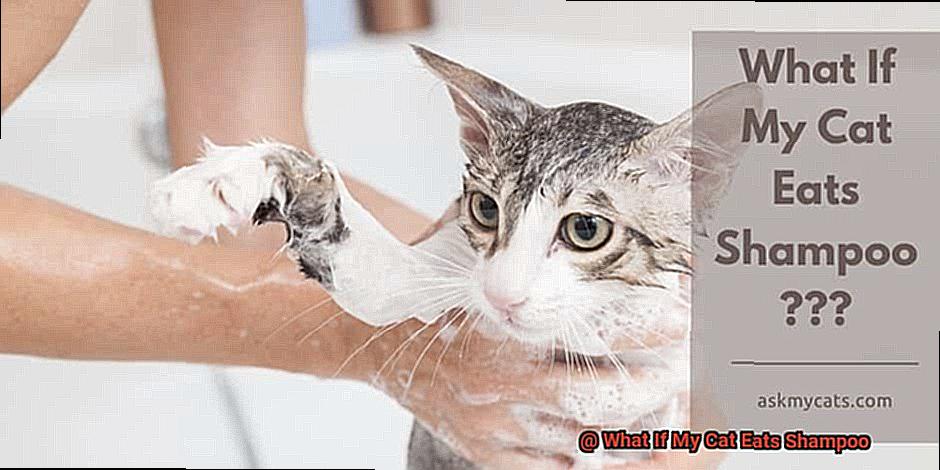
Use Safe Shampoo
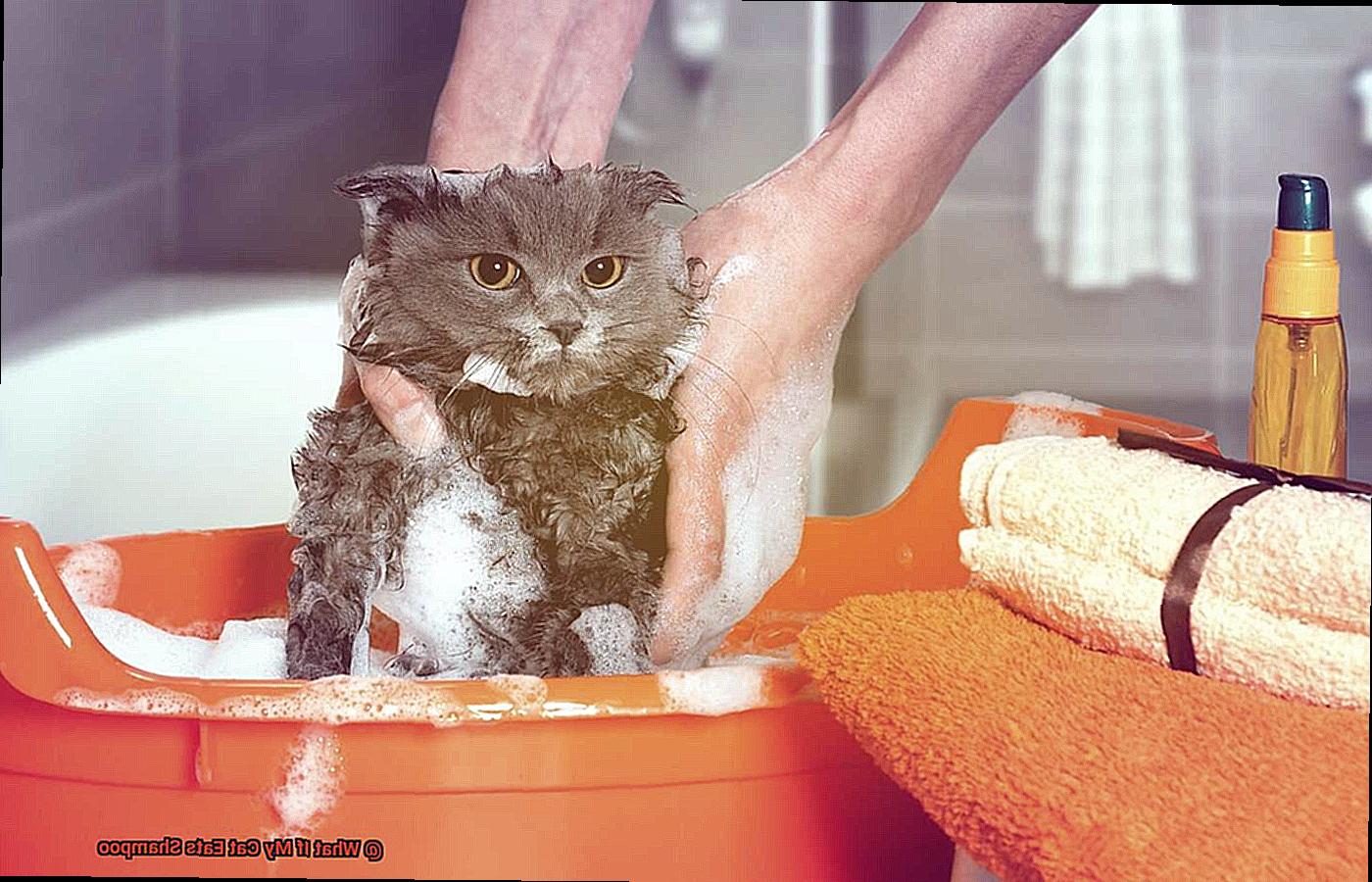
When bathing your cats, always use shampoo specifically made for cats. Human shampoos contain ingredients that are unsuitable for feline skin and hair, which can cause harm to your pet’s health. Consider using a no-rinse shampoo or wipes designed specifically for cats if you do not have access to cat shampoo.
Keep All Grooming Products Out of Reach
To prevent accidental ingestion by curious felines, keep all grooming products out of reach. Store them in a safe place where your cat cannot access them.
In conclusion, taking precautions and acting quickly is crucial when it comes to shampoo ingestion in cats. Always keep an eye on your cat’s behavior and seek veterinary attention if necessary.
Human Shampoos and Their Risks to Cats
Cats have a more sensitive and delicate skin than humans, which means that using human shampoo can cause irritation, dryness, and even chemical burns.
This is because the pH levels in human shampoo are different from those in cat-specific shampoos, which can also lead to skin irritations.
Moreover, some human shampoos contain ingredients that can be toxic to cats, such as essential oils or fragrances. If your cat accidentally ingests human shampoo, it can cause various symptoms like vomiting, diarrhea, lethargy, and loss of appetite.
In severe cases, it can even result in chemical burns in the mouth and throat, which can be life-threatening. Therefore, it is essential to keep all grooming products out of reach of cats and other pets.
If you have mistakenly used human shampoo on your cat, don’t worry. Rinse your cat thoroughly with warm water to remove any residue.
It is best to use cat-specific shampoo or mild baby shampoo to wash your feline friend. These shampoos are specially formulated to suit the pH balance of feline skin and do not contain harsh chemicals or fragrances.
In conclusion, using human shampoo on cats is not recommended as it can cause various health problems. It is always advisable to use cat-specific products for grooming your feline friend.
How to Safely Bathe Your Cat
While cats are natural-born groomers, they may occasionally require assistance with their hygiene.
Bathing your cat can be a daunting task, but with the right approach and safety precautions, it can be a positive experience for both you and your furry companion.
In this guide, we’ll explore some essential subtopics that will help you safely bathe your cat.
Choosing the Right Shampoo
When it comes to cat shampoo, never use human shampoo as it contains harsh chemicals that can irritate their sensitive skin. Instead, opt for a cat-specific shampoo that is free from any harmful chemicals and pH-balanced.
Read the label carefully before purchasing any shampoo for your cat to ensure it is suitable for their coat type and safe for their skin.
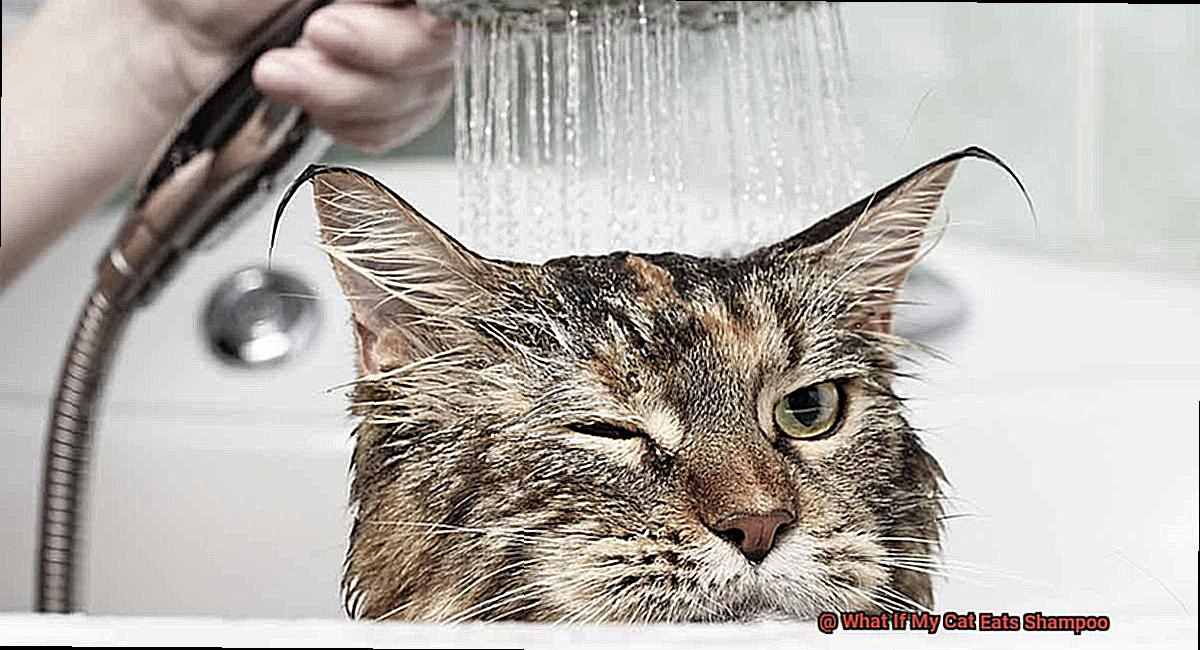
Preparing for the Bath
Before bathing your cat, prepare all necessary items such as towels, a non-slip mat for the bathtub or sink, and a gentle cat shampoo. It’s also essential to trim your cat’s nails beforehand to prevent any scratches or injuries. Choose a quiet location in your home where your cat feels comfortable and secure.
The Bathing Process
When it’s time to start bathing your cat, make sure the water temperature is lukewarm and not too hot or cold. Wet your cat down with a cup or spray bottle of water, being careful to avoid their face and ears. Apply a small amount of shampoo to your hands and work it into a lather before gently massaging it into their fur. Rinse thoroughly with warm water, ensuring all the soap is removed from their coat.
What to Do if Your Cat Accidentally Eats Shampoo
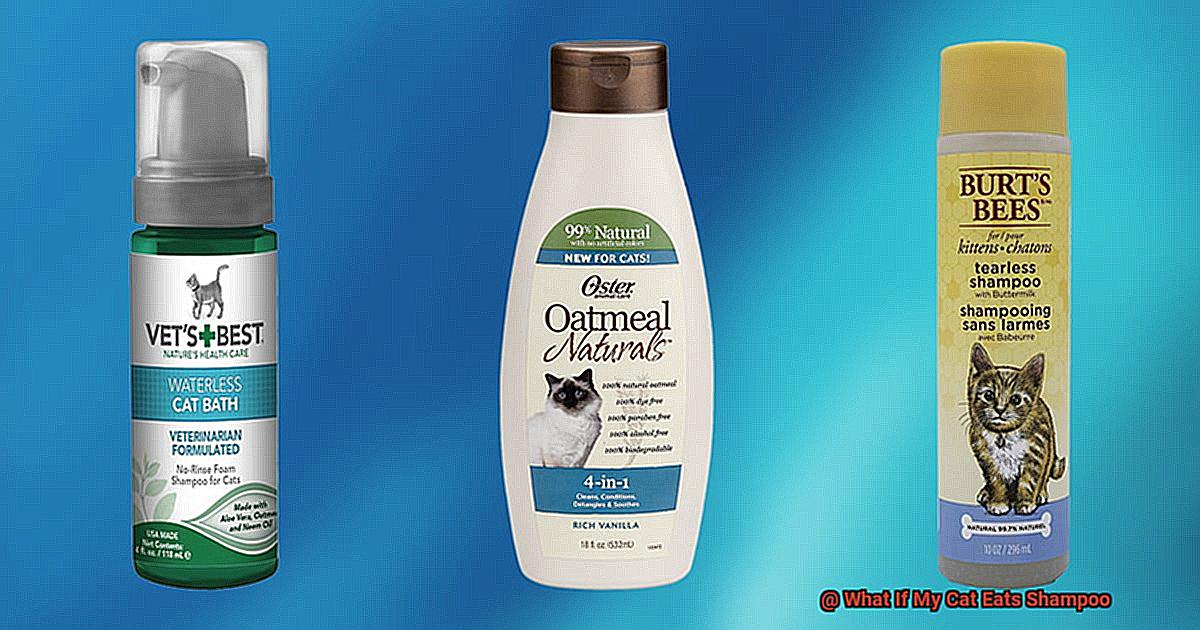
Accidents can happen during bath time, and if your cat ingests shampoo, call your veterinarian immediately. Depending on the type of shampoo and the amount ingested, it can be toxic and potentially fatal for cats. Symptoms of shampoo poisoning include vomiting, diarrhea, lethargy, and seizures.
In conclusion, bathing your cat may seem like a daunting task, but with proper preparation and safety measures in place, it can be a positive experience for both you and your furry friend.
Remember always to use cat-specific shampoos, avoid getting water or shampoo in sensitive areas, and seek veterinary care in case of accidental ingestion or severe symptoms.
dHw7O_cQ9KU” >
Prevention Tips to Keep Your Cat from Eating/Licking Shampoo
As cat lovers, we all want to ensure our furry friends stay healthy and safe. One of the potential dangers that we may overlook is the possibility of our cats ingesting shampoo. Luckily, there are simple yet effective prevention techniques that we can follow to keep our feline friends safe.
Use Cat-Specific Shampoo
Cat-specific shampoos are formulated with a feline’s sensitive skin and pH level in mind. Using human shampoo on your cat can cause skin irritation, vomiting, and diarrhea due to the harmful ingredients present in them. Always use a shampoo that is specifically made for cats to avoid any adverse reactions.
Keep Shampoo Bottles Out of Reach
Cats are curious creatures and may mistakenly ingest shampoo if they come across an open bottle or container. To prevent this from happening, store all shampoo bottles and cans in a place where your cat will not be able to reach them. This can be a tall shelf or locked cabinet.
Don’t Leave Your Cat Unattended During Bath Time
It’s important to supervise your cat during bath time to ensure they don’t accidentally ingest any shampoo. Keep a firm hold on your cat to prevent them from licking or ingesting any soap. You can also distract them with toys or treats while you’re washing them.
Rinse Thoroughly
After washing your cat with shampoo, make sure to rinse them thoroughly to remove all traces of soap from their fur. Leaving soap residue on their skin can result in skin irritation or even ingestion if they attempt to lick it off.
Use a Gentle Approach
Cats are sensitive creatures, so it’s crucial to use a gentle approach when washing them with shampoo. Use lukewarm water and a gentle stroke to make the experience as stress-free as possible for your cat.
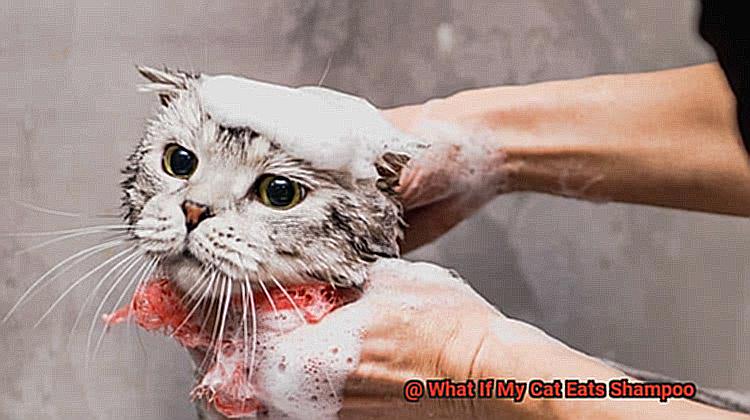
By following these prevention tips, you can help keep your cat safe from accidentally ingesting shampoo.
Remember, prevention is always better than cure, so it’s best to take steps to avoid any potential danger to your furry friend.
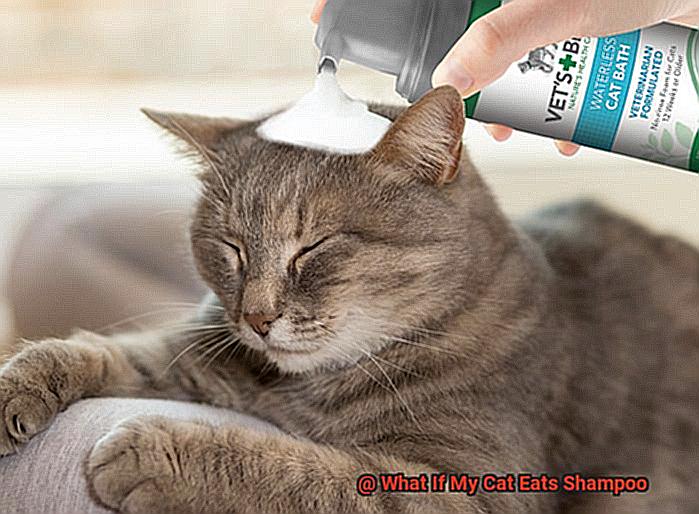
If you notice any signs of discomfort or adverse reactions in your cat after a bath, seek veterinary attention immediately.
Also Read: Can You Use Dove Soap On Your Cat?
Conclusion
To sum it up, being a responsible cat owner entails being mindful of the potential dangers of shampoo ingestion in cats and taking steps to prevent it.
Opting for cat-specific shampoos that are pH-balanced and free from harmful chemicals is crucial for their overall health and well-being. Additionally, keeping all grooming items out of reach of curious felines and supervising them during bath time can prevent accidental ingestion.
In case your furry friend does ingest shampoo, seeking immediate veterinary attention is vital as the symptoms can range from vomiting and diarrhea to seizures. As with most things in life, prevention is better than cure.
Our cats rely on us to keep them healthy, so let’s show them the respect they deserve by choosing the right products and taking necessary safety steps.

